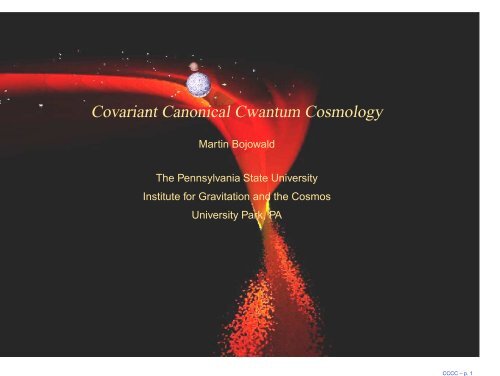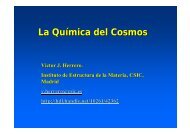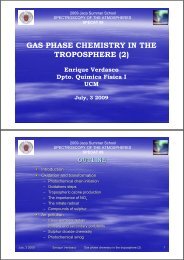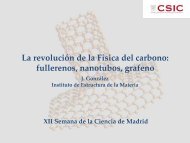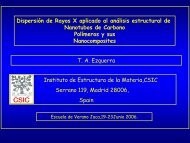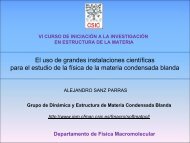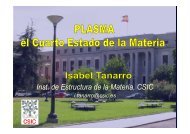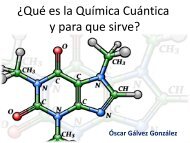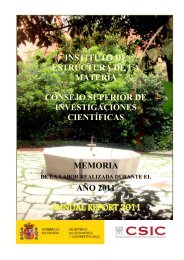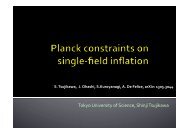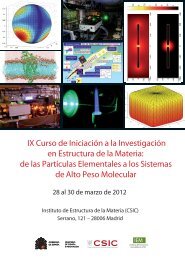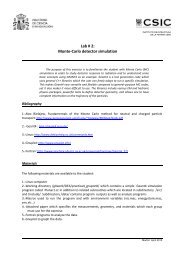Download the slides
Download the slides
Download the slides
You also want an ePaper? Increase the reach of your titles
YUMPU automatically turns print PDFs into web optimized ePapers that Google loves.
CCCC – p. 1<br />
Covariant Canonical Cwantum Cosmology<br />
Martin Bojowald<br />
The Pennsylvania State University<br />
Institute for Gravitation and <strong>the</strong> Cosmos<br />
University Park, PA
CCCC – p. 2<br />
Background independence<br />
Background independent quantizations of gravity must show that<br />
some form of space-time “emerges” at sufficiently low curvature.<br />
Not guaranteed.<br />
Canonical approaches: constraints are quantized, receive<br />
quantum corrections. Not just dynamics but also space-time<br />
structure (gauge content) may change.<br />
S = 1<br />
16πG<br />
∫<br />
d 4 x √ |detg|<br />
(<br />
)<br />
R+αR 2 +βR ab R ab +···<br />
?<br />
Must know space-time structure before deciding which covariant<br />
combinations of metric derivatives can appear.<br />
Not just R may receive quantum corrections but also “d 4 x,” or<br />
nature of covariance and space-time tensors.
CCCC – p. 3<br />
Loop quantum gravity<br />
−→ Holonomies h e = exp( ∫ e dλAi aė a τ i ) along curves e in space.<br />
Represented as operators, but not continuous in connection.<br />
No connection operator.<br />
−→ Holonomies as ladder operators raise excitation level of<br />
geometry by discrete steps.<br />
Densitized triad quantized as flux ∫ S d2 yn a Ê a i for surfaces S in<br />
space, with discrete spectrum containing zero.<br />
−→ Spatially diffeomorphism invariant: sum over all deformed<br />
graphs. Background independent: No metric used in basic<br />
operators.<br />
More tricky: Space-time covariance, Hamiltonian constraint.<br />
Background independence often forsaken at this stage.
CCCC – p. 4<br />
Quantum corrections<br />
−→ Inverse-triad corrections from quantizing [T Thiemann 1996]<br />
{ } √|detE|d<br />
Aa,∫ i 3 x<br />
= 2πGǫ ijk ǫ abc<br />
E b j Ec k<br />
√<br />
|detE|<br />
2.5<br />
Automatic cut-off of<br />
1/E-divergences.<br />
α (r)<br />
−→ Higher-order corrections:<br />
holonomies for A i a<br />
−→ Quantum back-reaction<br />
2<br />
1.5<br />
1<br />
0.5<br />
0<br />
0 0.5 1 1.5 2<br />
µ<br />
flux eigenvalues<br />
r=1/2<br />
r=3/4<br />
r=1<br />
r=3/2<br />
r=2
CCCC – p. 5<br />
Hypersurface-deformation algebra<br />
Diffeomorphism constraint D[w a ] and Hamiltonian constraint H[N].<br />
Classical algebra<br />
{D[w a 1],D[w a 2]} = −D[L w2 w a 1]<br />
{H[N],D[w a ]} = −H[w a ∇ a N]<br />
{H[N 1 ],H[N 2 ]} = D[h ab (N 1 ∇ b N 2 −N 2 ∇ b N 1 )]<br />
ensures that <strong>the</strong>ory respects<br />
→ gauge transformations for coordinate changes: space-time<br />
Lie derivative {f,H[ǫ]+D[ξ a ]} = L (ǫ/N,ξa +ǫN a /N)f if<br />
constraints satisfied and time direction t a = Nn a +N a . [Dirac]<br />
→ slicing independence: algebra amounts to deformations of<br />
hypersurfaces<br />
[Kuchar, Teiltelboim]<br />
Anomaly-free quantum-corrected constraints generate modified<br />
gauge transformations. Space-time?
CCCC – p. 6<br />
Background independence?<br />
Status of background independence in loop quantum gravity:<br />
(+) No spatial background metric used to define states and<br />
operators, summed over spatial diffeomorphisms.<br />
Uniqueness of representation.<br />
(−) Hamiltonian constraint quantized in much more messy way.<br />
Modify classical expression by holonomy corrections<br />
(quantum corrections mixed with regulator).<br />
(−) Diffeomorphism constraint and Hamiltonian constraint<br />
contain curvature of A i a, but treated differently.<br />
(−) Off-shell algebra of Hamiltonian constraints often ignored.<br />
[see also H Nicolai, K Peeters, M Zamaklar: hep-th/0501114]<br />
Can this procedure result in any consistent space-time picture?<br />
Energy conservation?
CCCC – p. 7<br />
Energy conservation<br />
[with M Kagan, G Hossain, C Tomlin: arXiv:1302.5695]<br />
N √ deth∇ µ T µ 0 = −N ∂H matter<br />
∂t<br />
−N a∂Dmatter a<br />
∂t<br />
+L ⃗N C matter [N,N a ]+ ∂h ab<br />
∂t<br />
+∂ b<br />
(<br />
N 2 h ab D matter<br />
a<br />
δH matter<br />
δh ab<br />
)<br />
+2N c h baδH matter<br />
δh ac<br />
Classical off-shell algebra: ∂H matter /∂t = {H matter ,H[N,N a ]}<br />
cancels ∂ a (N 2 D matter<br />
a ), only one term from ∂ b T b 0.<br />
→ Deformed algebra cannot be taken care of by modified<br />
coefficients in ∇ µ T µ ν = 0.<br />
→ No energy conservation if off-shell algebra broken<br />
(or unchecked in gauge-fixed/deparameterized models).
CCCC – p. 8<br />
Consistent loop quantum gravity<br />
→ Off-shell closed operator algebra of constraints likely?<br />
→ Semiclassical states (at dynamical level)?<br />
More realistic (at least in particle-physics analogy):<br />
Effective equations.<br />
→ Ease subtleties of factor ordering and quantum<br />
representation.<br />
→ Describe general classes of semiclassical states without<br />
requiring full wave function.<br />
(Vacuum problem of quantum gravity.)<br />
→ Can be generalized to constrained systems. Allow local<br />
internal times and time changes by gauge transformations.<br />
→ Simpler derivation of closed constraint algebras.<br />
But still incomplete.
CCCC – p. 9<br />
Effective canonical dynamics<br />
Parameterize state by expectation values 〈ˆq〉 and 〈ˆp〉 of basic<br />
operators and moments<br />
(Includes mixed states.)<br />
G a,n = 〈(ˆq −〈ˆq〉) a (ˆp−〈ˆp〉) n−a 〉 symm<br />
Commutator of operators determines Poisson bracket of<br />
moments. (Symplectic space, but not after restriction to finite n.)<br />
Expectation value of Hamiltonian, interpreted as function of 〈ˆq〉,<br />
〈ˆp〉 and G a,n , provides canonical equations of motion.<br />
Effective equations: Correct classical equations for 〈ˆq〉, 〈ˆp〉 by<br />
quantum back-reaction from moments.<br />
[with A Skirzewski: math-ph/0511043]
CCCC – p. 10<br />
Quantum equations of motion<br />
Anharmonic oscillator:<br />
˙q = p m<br />
ṗ = −mω 2 q −U ′ (q)− ∑ n<br />
1<br />
n!<br />
( ) n/2<br />
U (n+1) (q)˜G 0,n<br />
mω<br />
˙˜G a,n = −aω ˜G a−1,n +(n−a)ω ˜G a+1,n −a U′′ (q)<br />
mω<br />
√<br />
aU ′′′ (q)<br />
+<br />
2(mω) 3 2<br />
(√<br />
U ′′′ (q)<br />
− a 2<br />
(mω) 3 2<br />
˜G<br />
a−1,n<br />
˜G a−1,n−1 ˜G0,2 (q)<br />
+ aU′′′′ a−1,n−1 ˜G ˜G0,3<br />
3!(mω) 2<br />
˜G a−1,n+1 + U′′′′ (q)<br />
3(mω) 2 ˜G a−1,n+2 )<br />
∞ly many coupled equations for ∞ly many variables.<br />
+···
CCCC – p. 11<br />
Low energy effective action<br />
To second adiabatic order, as second order equation of motion:<br />
( )<br />
as it results from<br />
Γ eff [q(t)] =<br />
m+<br />
U ′′′ (q) 2<br />
32m 2 ω 5 (1+ U′′ (q)<br />
mω 2 ) 5 2<br />
+ ˙q2 (<br />
4mω 2 U ′′′ (q)U ′′′′ (q)<br />
+mω 2 q +U ′ (q)+<br />
(<br />
¨q<br />
128m 3 ω 7 (1+ U′′ (q)<br />
mω 2 ) 7 2<br />
) )<br />
1+ U′′ (q)<br />
mω 2 −5U ′′′ (q) 3<br />
U ′′′ (q)<br />
4mω(1+ U′′ (q)<br />
mω 2 ) 1 2<br />
= 0.<br />
∫ ( (<br />
)<br />
1 U ′′′ (q) 2<br />
dt m+<br />
2 2 5 m 2 (ω 2 +m −1 U ′′ (q)) 5 2<br />
− 1 2 mω2 q 2 −U(q)− ω ( )<br />
)1<br />
1+ U′′ (q)<br />
2<br />
2 mω 2<br />
˙q 2
Higher time derivatives<br />
Higher adiabatic order:<br />
[with S Brahma, E Nelson: arXiv:1208.1242]<br />
¨q = −ω 2 q −U ′ (q)/m<br />
where<br />
− <br />
2m 2 ω U′′′ (q) ( f(q, ˙q)+f 1 (q, ˙q)¨q +f 2 (q)¨q 2 +f 3 (q, ˙q)˙¨q +f 4 (q)¨q )<br />
+···<br />
( ) −1/2 ( ) −5/2<br />
f(q, ˙q) = 1 2<br />
1+ U′′ (q)<br />
mω +<br />
U ′′′′ (q)˙q 2<br />
2 16mω<br />
1+ U′′ (q)<br />
4 mω −<br />
5(U ′′′ (q)) 2 ˙q 2<br />
2 64m 2 ω<br />
(1+ 6<br />
( ) −7/2 ( ) −9/2<br />
− U′′′′′′ (q)˙q 4<br />
64mω<br />
1+ U′′ (q)<br />
6 mω +<br />
21(U ′′′′ (q)) 2 ˙q 4<br />
2 256m 2 ω<br />
1+ U′′ (q)<br />
8 mω 2<br />
( ) −9/2 (<br />
+ 7U′′′′′ (q)U ′′′ (q)˙q 4<br />
64m 2 ω<br />
1+ U′′ (q)<br />
8 mω −<br />
231U ′′′′ (q)(U ′′′ (q)) 2 ˙q 4<br />
2 512m 3 ω<br />
1+ U′′ (q<br />
10 mω 2<br />
( ) −13/2<br />
+ 1155(U′′′ (q)) 4 ˙q 4<br />
4096m 4 ω<br />
1+ U′′ (q)<br />
12 mω 2 CCCC – p. 12
CCCC – p. 13<br />
Effective constraints<br />
Dynamics by effective Hamiltonian<br />
constraints 〈̂polĈ〉(〈·〉,∆(·)).<br />
→ Captures dynamics<br />
of physical states.<br />
→ Allows local internal times.<br />
[arXiv:1009.5953]<br />
[Figure from arXiv:0911.4950]<br />
Α 0<br />
〈Ĥ〉(〈·〉,∆(·)) or effective<br />
p Α<br />
Α 0<br />
Α 0<br />
.5Α 0<br />
.5Α 0<br />
.5Α 0<br />
Α 0<br />
.5Α 0<br />
Α<br />
[Cosmological model in P Höhn, E Kubalova, A Tsobanjan: arXiv:1111.5193]
CCCC – p. 14<br />
Effective constraint algebras<br />
Systems with several classical constraints C I :<br />
→ Effective constraints C I,pol = 〈̂polĈI〉(〈·〉,∆(·)) with ̂pol<br />
polynomial in basic operators.<br />
→ Compute effective constraint algebra by Poisson brackets.<br />
Easier than commutators of operators. Parameterizable.<br />
→ Check off-shell consistency of first-class constraints.<br />
Example: Hamiltonian and diffeomorphism constraints obey<br />
hypersurface-deformation algebra of classical space-time.<br />
{D[w a 1],D[w a 2]} = −D[L w2 w a 1]<br />
{H[N],D[w a ]} = −H[w a ∇ a N]<br />
{H[N 1 ],H[N 2 ]} = D[h ab (N 1 ∇ b N 2 −N 2 ∇ b N 1 )]
CCCC – p. 15<br />
Relevance of effective methods<br />
→ “Big-bang state” largely unknown.<br />
Consider generic states in effective parameterization.<br />
→ Local internal times: Do not require artificial matter contents<br />
such as free, massless scalar or dust.<br />
→ No gauge-fixing or deparameterization, or solution of<br />
classical constraints required before quantization:<br />
Check off-shell consistency of constraint algebra and<br />
corresponding space-time structure.<br />
Quantum space-time structure derived, not presupposed.<br />
Surprises . . .
CCCC – p. 16<br />
Homogeneous models<br />
Dynamics poorly understood even in homogeneous models.<br />
(Even kinematics [arXiv:1206.6088].)<br />
In most cases, restricted not just by symmetry but also, and<br />
crucially, by matter ingredients.<br />
→ Usual choices of matter (for deparameterization) or states<br />
(Gaussian) eliminate most quantum back-reaction, too<br />
restrictive.<br />
→ Symmetry eliminates control on space-time structure.<br />
Homogeneous models trivialize <strong>the</strong> constraint algebra,<br />
crucial issues overlooked.<br />
Need realistic matter and at least perturbative inhomogeneity to<br />
obtain propagation equations and see if and how structure<br />
evolves through high density.
CCCC – p. 17<br />
Deformed deformations<br />
−→ Inverse-triad corrections in Hamiltonian<br />
1<br />
16πG<br />
∫<br />
d 3 xNα ǫ ijkF i ab Ea j Eb k<br />
√<br />
|detE|<br />
+···<br />
−→ Poisson-bracket algebra modified.<br />
Deform but do not violate covariance:<br />
{D[w a 1],D[w a 2]} = −D[L w2 w a 1]<br />
{H[N],D[w a ]} = −H[w a ∇ a N]<br />
{H[N 1 ],H[N 2 ]} = D[α 2 h ab (N 1 ∇ b N 2 −N 2 ∇ b N 1 )]<br />
[with G Hossain, M Kagan, S Shankaranarayanan: arXiv:0806.3929]
CCCC – p. 18<br />
Space-time?<br />
Deformed gauge algebra implies that <strong>the</strong>ory is no longer<br />
invariant under space-time diffeomorphisms.<br />
Same number of gauge generators: <strong>the</strong>ory remains consistent.<br />
Can be evaluated with canonical methods (Hamiltonian<br />
equations of motion, gauge transformations, observables, . . . ).<br />
But no analog of space-time metric or line element:<br />
ds 2 = g ab dx a dx b<br />
not invariant since transformations of g ab and dx a no longer<br />
match.<br />
(Warning for homogeneous models or perturbations:<br />
Often, “effective” FLRW metric −dt 2 +a(t) 2 (dx 2 +dy 2 +dz 2 )<br />
assumed with a(t) subject to modified Friedmann equation.)
CCCC – p. 19<br />
Cosmological perturbation equations<br />
[with G Calcagni: arXiv:1011.2779]<br />
Dynamics of density perturbations u, gravitational waves w:<br />
−u ′′ +s(α) 2 ∆u+(˜z ′′ /˜z)u = 0<br />
−w ′′ +α 2 ∆w +(ã ′′ /ã)w = 0<br />
Wave equations. Corrections to tensor-to-scalar ratio.<br />
2.5<br />
2<br />
Do not need high density.<br />
Crucial for falsifiability:<br />
α−1 large for small lattice spacing.<br />
Two-sided bounds on<br />
discreteness scale.<br />
α (r)<br />
1.5<br />
1<br />
0.5<br />
0<br />
0 0.5 1 1.5 2<br />
µ<br />
r=1/2<br />
r=3/4<br />
r=1<br />
r=3/2<br />
r=2
Scalar mode<br />
−u ′′ +s(α) 2 ∆u+(˜z ′′ /˜z)u = 0 [with G Calcagni, S Tsujikawa 2011]<br />
1 x 10−4<br />
0.9<br />
0.8<br />
10 −8 < δ = α−1 < 10 −4<br />
0.7<br />
0.6<br />
much closer than<br />
δ (k 0<br />
)<br />
0.5<br />
0.4<br />
0.3<br />
0.2<br />
0.1<br />
l P and l H<br />
0<br />
0 0.005 0.01<br />
ε (k ) V 0<br />
0.015 0.02<br />
CCCC – p. 20
CCCC – p. 21<br />
Holonomy corrections<br />
Hypersurface-deformation algebra with pointwise holonomy<br />
corrections: H −→ l −1 sin(lH) in perturbative cosmology.<br />
Incomplete: Corrections in series expansion cannot be<br />
separated from higher space and time derivatives. (R ∼ ∂Γ+Γ 2 )<br />
with β = cos(2lH).<br />
[S(⃗w 1 ),S(⃗w 2 )] = −S(L ⃗w2 ⃗w 1 )<br />
[T(N),S(⃗w)] = −T(⃗w · ⃗∇N)<br />
[T(N 1 ),T(N 2 )] = S(β(N 1<br />
⃗ ∇N2 −N 2<br />
⃗ ∇N1 ))<br />
−w ′′ +β∆w +(ã ′′ /ã)w = 0<br />
β = −1 at maximal density (maximum of sin(lH), “bounce”).<br />
[J Reyes 2009; A Barrau, T Cailleteau, J Grain, J Mielczarek 2011]
CCCC – p. 22<br />
Signature change<br />
β ≈ −1 at high density.<br />
Space-time signature Euclidean.<br />
[with G Paily: arXiv:1112.1899]<br />
c∆t<br />
v/c<br />
Minkowski geometry<br />
Euclidean geometry
CCCC – p. 23<br />
Ill-posed bounce<br />
Bounce models require high density, where signature turns<br />
Euclidean.<br />
→ Quantum space-time: no metric/line element, but deformed<br />
constraint algebra determines space(-time) structure.<br />
→ Physical consequence: elliptic ra<strong>the</strong>r than hyperbolic partial<br />
differential equations for physical modes.<br />
No deterministic evolution. No initial-value problem.<br />
→ Signature change not a consequence of small<br />
inhomogeneity:<br />
Inhomogeneity only used to probe space-time structure<br />
because homogeneous models are too restrictive.<br />
→ Does not rely on subtleties of perturbation <strong>the</strong>ory:<br />
Same effects in spherically symmetric models.
CCCC – p. 24<br />
Some recent results<br />
Off-shell constraint algebra.<br />
Operator results encouraging and fully consistent with effective<br />
calculations.<br />
[A Perez, D Pranzetti: arXiv:1001.3292]<br />
[A Henderson, A Laddha, C Tomlin: arXiv:1204.0211, arXiv:1210.3960]<br />
[C Tomlin, M Varadarajan: arXiv:1210.6869]<br />
Derivative expansion for integrated holonomies.<br />
Work in progress. [with G Paily and J Reyes]<br />
Combination of inverse-triad and holonomy corrections.<br />
Work in progress. [T Cailleteau]
CCCC – p. 25<br />
Models of quantum space-time<br />
(Weak) relation with doubly special relativity.<br />
[MB, G Paily: arXiv:1212.4773 ]<br />
Holonomy-deformation interpreted as version of κ-Poincaré:<br />
−→ Linear N and ⃗w and flat space produce Poincaré if β = 1.<br />
−→ For β ≠ 1, dependence on extrinsic curvature takes <strong>the</strong> form<br />
of non-linear energy dependence at boundaries.<br />
−→ However, this version does not act on standard κ-Minkowski.<br />
Background independence and form of quantum space-time<br />
remain unclear in loop quantum gravity.<br />
Homogeneous models and most extensions do not grasp<br />
quantum space-time structure.<br />
Not an approximation: just anomalous.


